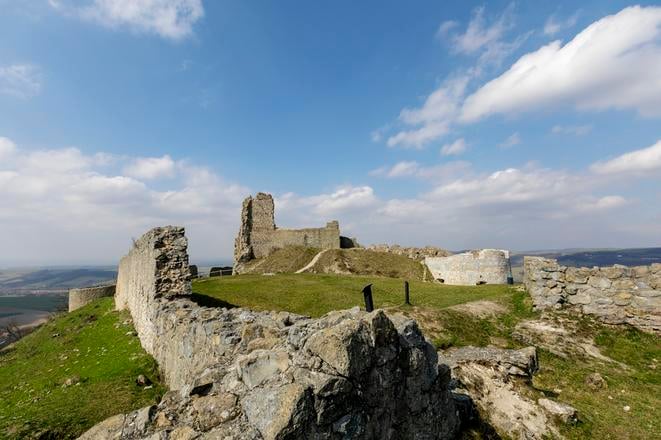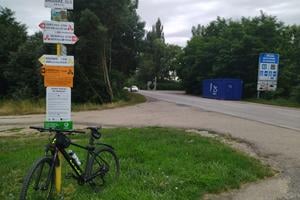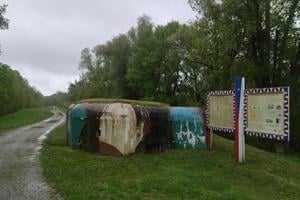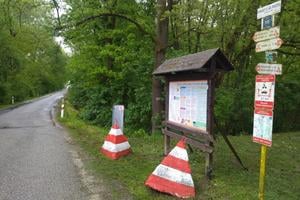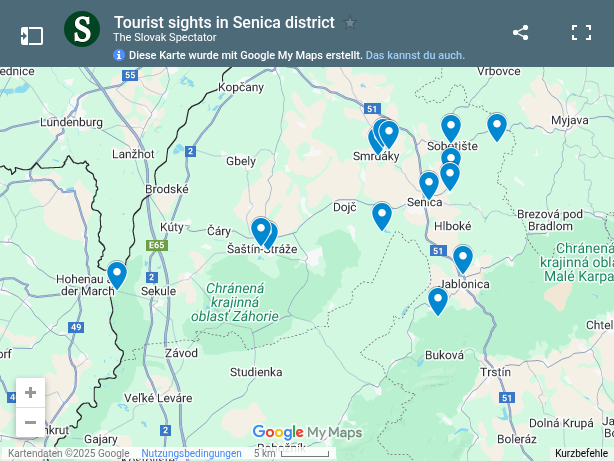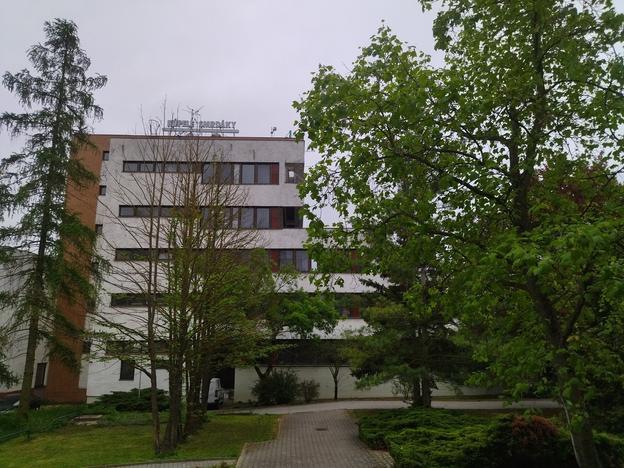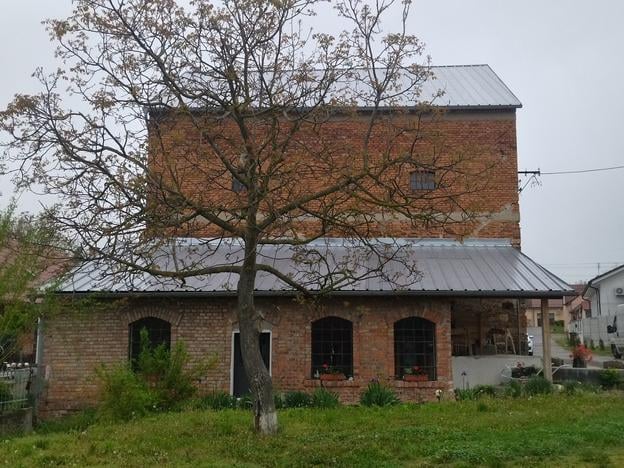You can read this exclusive content thanks to the FALATH & PARTNERS law firm, which assists American people with Slovak roots in obtaining Slovak citizenship and reconnecting them with the land of their ancestors.
In a quiet pocket of western Slovakia, history, nature and leisure converge in ways both sobering and serene.
The Senica district offers more than just scenic views — it promises a journey through time and terrain. Cyclists, water sports enthusiasts, golfers and lovers of historical monuments and churches will all find something to enjoy here.
Travellers can begin their route with a bicycle ride along the Morava River. Near the village of Moravský Svätý Ján, a bridge leads into neighbouring Austria and the village of Hohenau.
Along the way, remnants of Czechoslovakia’s turbulent past come into view. Military bunkers, built to defend the country from German expansionism before the Second World War, stand as silent witnesses to a failed defence. Later, this border zone became part of the Iron Curtain — this time said to shield Slovaks from Western imperialism.
Continuing along the Morava River, visitors pass through the village of Borský Svätý Jur, where the Chapel of Our Lady of Lourdes stands. Built at the end of the 19th century by local residents Juraj Holý and Juliana Hušková, the chapel features a distinctive blue façade and is easily visible from the main road.
On the way towards Senica, a stop in the town of Šaštín-Stráže offers the chance to see another important religious monument: the Basilica of Our Lady of Sorrows. Constructed in the first half of the 18th century, this grand church is closely linked to the veneration of the statue of Our Lady of Sorrows and draws tens of thousands of pilgrims each year.
The town is also home to a mid-19th-century Jewish synagogue, which currently stands neglected and in need of restoration.
Smrdáky offers healing waters
Taking a short detour from the main road to the district town can prove rewarding. One notable stop is the spa in Smrdáky, a village that shares its name with the therapeutic retreat. The spa is known for its unique mineral water, rich in hydrogen sulphide, which has proven effective in the treatment of various skin conditions. The strong odour of the water — owing to its high sulphur content — is also the origin of the village’s name. In addition to the water, the local sulphuric mud is celebrated for its healing properties.
The spa is operated by the international company Ensana, which also manages a well-known facility in Piešťany. Nearby, a large park offers a peaceful space for relaxation. However, some of the spa buildings are in a state of disrepair and would benefit from further investment to restore them to their former splendour.
Just beyond Smrdáky lies the village of Rybky, where visitors should take a moment to admire the Millennium Cross. Standing 27 metres tall, this striking monument was erected to mark the 2000th anniversary of the birth of Jesus Christ. Positioned on flat terrain, the cross commands attention with its imposing presence.
The water mill in Čáčov serves as a museum
In the town of Senica, a visit to the local museum — housed in a beautifully restored manor house — is well worth the time. Alongside its permanent archaeological and historical displays, the museum frequently hosts temporary exhibitions.
While Senica itself has few remaining historical monuments, the old water mill in the nearby village of Čáčov, now a part of the town, offers a fascinating glimpse into the past. A group of dedicated enthusiasts restored the mill in 2011, preserving a valuable piece of local heritage.
The Slovak Spectator visited the site following a recommendation from a historian at the Senica Museum. The mill, a three-storey brick structure, contains well-preserved and functional milling equipment. Inside, visitors can view a collection of historical photographs, including images of the last owner and miller, Pavel Škodáček.
Spread across all three floors, the exhibition showcases traditional milling techniques and recounts the history of the Škodáček family, who operated the mill until it was nationalised by the state in 1960. After that, it no longer produced flour but was used to process grain for cattle feed.
The Škodáček family regained ownership following the fall of the communist regime but did not resume flour milling. The current owner, Peter Pivák, later acquired the property and undertook a full renovation, transforming the site into a museum.
A highlight of the visit is the extension dedicated to Senica ceramics. In the courtyard, a large barn serves as a venue for community events. While the museum does not have regular opening hours, visitors can arrange a tour by calling ahead.
Castles and beaches with a Caribbean feel
For castle enthusiasts, the village of Podbranč is a must-visit, as it is home to the picturesque ruins of Branč Castle. The site is accessible via a path from the car park near the cemetery. The ascent is gentle, with the hill offering an easy climb.
On your way back, consider stopping in the nearby town of Sobotište, where the beautifully restored Habánsky Mill awaits. The mill also houses a small museum dedicated to the Habáns, a historic religious group that once lived in the area.
For those in search of a swim with a tropical twist, Kunovská Dam offers a sandy beach that evokes the atmosphere of a Caribbean getaway. The site also features a charming observation tower with views over the reservoir.
And for lovers of sand and desert landscapes, the Šranecké Piesky protected area is not to be missed. Its natural sand dunes create a scene reminiscent of the Sahara. Do note, however, that access is restricted to weekends only, as the area lies within a military zone.
What to see in the Senica district
Discover Slovakia with our Spectacular Slovakia travel guide.
Churches and religious monuments
Chapel of Our Lady of Lourdes, Borský Svätý Jur
Basilica of Our Lady of Sorrows, Šaštín-Stráže
Jewish Synagogue (mid-19th century), Šaštín-Stráže
Millennium Cross, Rybky
Sports, activities and spa
Military bunkers, near Moravský Svätý Ján - fortifications from 1938
Smrdáky Spa - a spa complex with a pleasant, spacious park
Penati Golf Resort, Šajdíkové Humence
Kunovská Dam - ideal for recreation and water sports
Šranecké Piesky - a protected natural area with sand dunes
Museums and castles
Senica Museum - learn about the town’s history in the heart of Záhorie
Záhorie Gallery, Senica - housed in a late Baroque mansion
Water Mill, Čáčov - with preserved and functional milling technology
Branč Castle - ruins above the village of Podbranč
Korlátka Castle - ruins near the village of Cerová
Habán Museum, Sobotište
Peasantry Museum, Prietrž
Birthplace of Ján Hollý, Borský Mikuláš - childhood home of the renowned Slovak poet
Jablonica Manor - a Renaissance manor, awaiting reconstruction
Belfry and Ice House in Kunov - restored historical monuments


